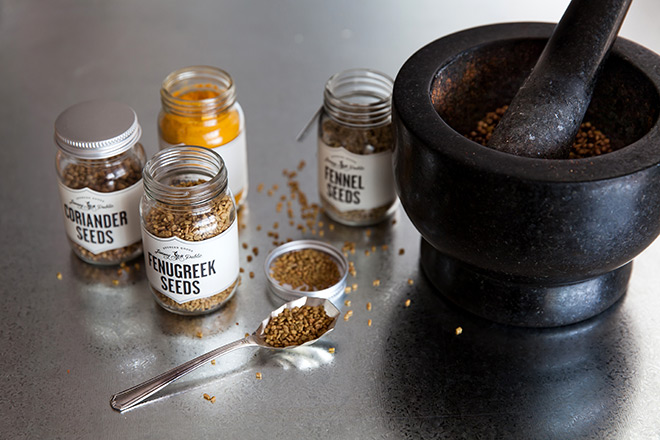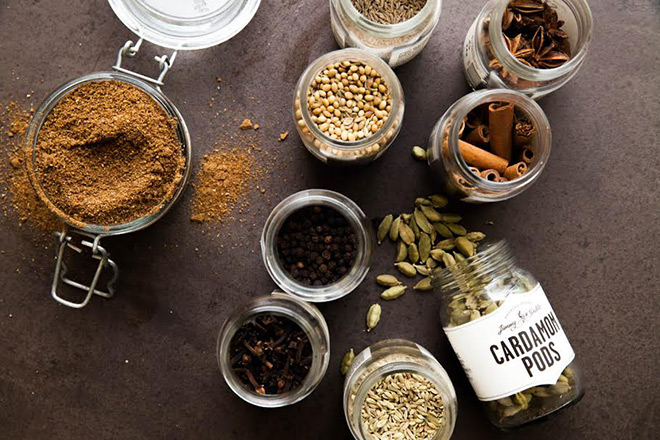Why you should be spring cleaning your spice cupboard

There’s no better time to give your cupboard a spring clean, getting rid of that turmeric from ’96 and the chicken spice that has moved house with -twice! Once you know which spices to stock your cupboard with to suit your cooking style (and which are good add ons for creative culinary ventures) you’ll find your spice cupboard to be a thing of inspiration and joy rather than the dusty kitchen crevice you’d rather just avoid.
How to tell if you need to chuck out your spices
As with most things there’s a general rule of thumb to work with:
- Herbs last between 1–3 years
- Whole spices and extracts between 3–4 years
- Ground spices and seasoning blends between 2–3 years
If your dried herbs are from your student days, you will notice they’re no longer green but a little faded and brown and if you sprinkle some onto your hand, give them a little rub, inhale and taste – well, it might be more like palatable sawdust than aromatic oregano. The same applies for spices – paprika and other bright spices will discolour and you’ll have to try hard to smell any of those lovely aromas if you break open a whole spice or start pounding them with a pestle and mortar. Spices are not hugely expensive so it’s worth replacing old bottles with new and rather flavouring your dishes as you, or your recipe, intended.
How to store spices to make them last longer
- Keep your spices in a dark cupboard, away from direct sunlight.
- Store them in airtight containers.
- Make them accessible so that you actually use them. Ever watched Michael McIntyre’s take on the spice cupboard? You’ll never be able to think about Five Spice in the same way again.
- Label them clearly – if you’re buying in bulk, sort out into airtight containers and make sure you label them so you know how hot that curry powder really is. If your spice cupboard looks beautiful too – like perhaps with a set from Jimmy Public, you’re probably more likely to make use of them.
- Don’t sprinkle any spice or herb bottle directly over a boiling pot – the water vapour can cause them to spoil.

These are the spices you really need
You don’t need every spice under the sun unless you are Heston Blumenthal. Having too many can make the spice cupboard difficult to navigate. Do you love curry? Are you basing your meal plan around the Real Meal Revolution? Think about those cuisines and build your cupboard around your general food preferences.
Basic herbs
Dried herbs shouldn’t replace fresh. If you have a balcony, garden or windowsill try growing your own parsley, thyme, sage, mint, oregano, coriander, basil and bay. But that’s not to say that dried herbs don’t have their place, especially when the fresh herbs aren’t possible or have been savaged by rampaging caterpillars. Use dried herbs early in the cooking process and fresh herbs at the end.
- Dried rosemary – sprinkle onto roast lamb, roast potatoes
- Dried oregano – for any Greek flavour, lamb chops or calamari and lemon
- Mixed herbs – for that emergency soup pot
The basic spices
Some cookbooks never die and Jamie Oliver’s Naked Chef is one of them. He suggests these nine spices as essentials:
- Black peppercorns
- Dried chillies
- Nutmeg
- Cloves
- Coriander seeds
- Fennel seeds
- Cumin seeds
- Caraway seeds
The Jimmy Public Essential Kitchen Cupboard set includes:
- Salt flakes
- Black peppercorns
- Coriander seeds
- Cumin seeds
- Chilli flakes
- Yellow mustard seeds
And you can buy this set and have it delivered to your spice cupboard, for free.
‘Real Meal Revolution’ Banting spices:
These spices are used most often in the Real Meal Revolution book:
- Black peppercorns
- Salt flakes
- Sesame seeds
- Cinnamon
- Ground coriander
- Ground cardamom
- Paprika (sweet and smoked)
- Ground caraway seeds
- Cumin seeds
- Ground cumin
- Dried oreganum
- Ground nutmeg
- Chinese five spice
- Dried thyme
- Cayenne pepper
- Turmeric
- Dried chilli
- Yellow mustard seeds
…and coconut oil of course.
Curry lover spices
Love a Friday night curry? Then you had better stock up:
- Cayenne pepper
- Cumin seeds
- Coriander seeds
- Ground turmeric
- Chilli flakes
- Fenugreek seeds
- Whole cinnamon sticks
- Fennel seeds
- Whole black peppercorns
- Whole cloves
- Cardamom pods
- Star anise
Here is a great recipe for a do-it-yourself garam masala and a handy set for Jimmy Public curry spices.

Spice for the baker
Love to bake? These spices will add that extra depth to your cakes and bakes.
- Whole cinnamon sticks
- Cardamom pods
- Allspice
- Whole cloves
- Whole nutmeg
- Star anise
- Caraway seeds
- Black sesame seeds
Spices for pickling
If pickling is your thing, then these are the spices you need to have at your beck and call:
- Coriander seeds
- Whole black peppercorns
- Brown mustard seeds
- Yellow mustard seeds
- Allspice
- Whole cloves
Recipes that will inspire you to cook with spices
If you have the same spices in your cupboard and you are on auto-pilot when you do your weekly shop, you might find that a lot of your food tastes pretty similar or it’s difficult to try something new. Spices have the power to change that. Here are some delicious recipes using interesting but commonly found spices:
- Patatas Bravas (spicy potatoes)
- Easy chicken spice blend
- Five Spice crispy duck with sticky plums
- Barbecue popcorn (for curling up on the couch)
- How to make chai tea
- Chicken curry with homemade garam masala
- Spiced chocolate cake

More spice know-how
Check out these articles to get more out of those spices:
- Flavours, recipes and know-how on cooking with turmeric
- How to use allspice in your cooking
- Everything you need to know about fennel seeds
- Insight on cooking with cayenne pepper
Inspired to get sorting and clean out your stale spices while shaking up your everyday meal repertoire? There couldn’t be a better time. Happy spice spring cleaning.
